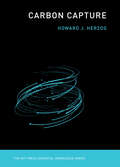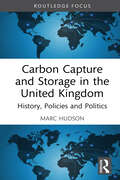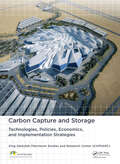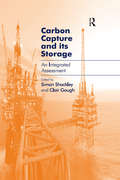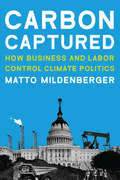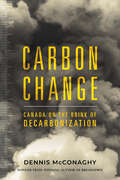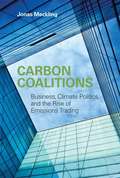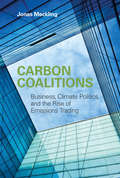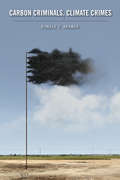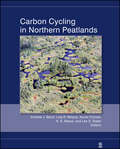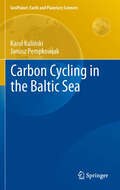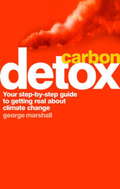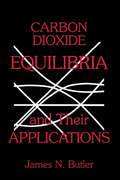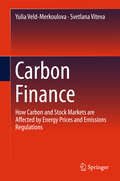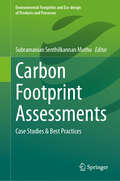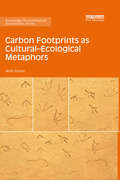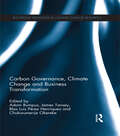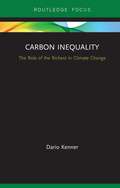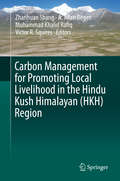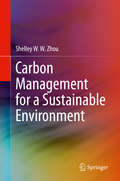- Table View
- List View
Carbon Capitalism and Communication: Confronting Climate Crisis (Palgrave Studies In Media And Environmental Communication)
by Graham Murdock Benedetta BreviniThis volume examines the role of communication in contributing to and contesting the current climate crisis. There is now widespread agreement that even if increases in carbon emissions are kept to the current international target the climate crisis will continue to intensify. This book brings together, for the first time, state-of-the-art research with activists' interventions to place debate around climate crisis within the wider conversation about the changing relations between communications and contemporary capitalism. Contributors include; Naomi Klein, Michael Mann, Alan Rusbridger, Vincent Mosco, Jodi Dean, and leading figures in Greenpeace and 350. org.
Carbon Capture (The MIT Press Essential Knowledge series)
by Howard J. HerzogA concise overview of carbon dioxide capture and storage (CCS), a promising but overlooked climate change mitigation pathway.The burning of fossil fuels releases carbon dioxide (CO2), and these CO2 emissions are a major driver of climate change. Carbon capture offers a path to climate change mitigation that has received relatively little attention. In this volume in the MIT Press Essential Knowledge series, Howard Herzog offers a concise guide to carbon capture, covering basic information as well as the larger context of climate technology and policy. Carbon capture, or carbon dioxide capture and storage (CCS), refers to a suite of technologies that reduce CO2 emissions by “capturing” CO2 before it is released into the atmosphere and then transporting it to where it will be stored or used. It is the only climate change mitigation technique that deals directly with fossil fuels rather than providing alternatives to them. Herzog, a pioneer in carbon capture research, begins by discussing the fundamentals of climate change and how carbon capture can be one of the solutions. He explains capture and storage technologies, including chemical scrubbing and the injection of CO2 deep underground. He reports on current efforts to deploy CCS at factories and power plants and attempts to capture CO2 from the air itself. Finally, he explores the policies and politics in play around CCS and argues for elevating carbon capture in the policy agenda.
Carbon Capture and Storage in the United Kingdom: History, Policies and Politics (Routledge Focus on Energy Studies)
by Marc HudsonThis book is a concise but comprehensive guide to the history, present and possible futures of carbon capture and storage policy and action in the United Kingdom (UK).There have been multiple failed starts, promises and “last chances” for carbon capture and storage (CCS) in Europe, North America, China and Australia, but thus far it has repeatedly collided with the political and economic realities that the technology is too expensive and complicated to gain and keep policymakers’ support. However, in the UK that might be changing, with explicit government support for CCS to help decarbonise industry. Set within the broader context of global interest in CCS, this book first outlines the technologies involved in the types of capture technology, transport options and storage options in the UK. It then briefly introduces an overarching policy analysis framework (John Kingdon’s multiple streams approach) and uses it to give an account of the long history of CCS interest and efforts in three chapters covering the 1970s to 2002, 2003 to 2015 and 2016 to the present day. Marc Hudson focusses on the various arguments made for the introduction of CCS, and the slowly shifting coalitions of actors who make those arguments, while contrasting these with the perspectives of those opposed to CCS.This book will be of great interest to students, scholars and policymakers researching and working in the field, as well as the related areas of energy policy, energy transitions and climate change.
Carbon Capture and Storage: Technologies, Policies, Economics, and Implementation Strategies
by King Abdullah Petroleum Studies Saud M. Al-Fattah Murad F. Barghouty Bashir O. DabbousiThis book focuses on issues related to a suite of technologies known asCarbon Capture and Storage (CCS), which can be used to capture and store underground large amounts of industrial CO2 emissions. It addresses how CCS should work, as well as where, why, and how these technologies should be deployed, emphasizing the gaps to be filled in terms o
Carbon Capture and its Storage: An Integrated Assessment
by Clair GoughClimate change is arguably the most important environmental issue that the world currently faces. Carbon Capture and Storage (CCS) offers the possibility of significant reductions in the volume of CO2 released into the atmosphere in the near to medium term. As a fairly new technology that has not been widely adopted, there remain some uncertainties related to both viability and desirability. This book discusses the key issues with regard to technical and legal feasibility, economic viability and public and stakeholder perceptions. It also provides recommendations for policy and future research.
Carbon Captured: How Business and Labor Control Climate Politics (American and Comparative Environmental Policy)
by Matto MildenbergerA comparative examination of domestic climate politics that offers a theory for cross-national differences in domestic climate policymaking.Climate change threatens the planet, and yet policy responses have varied widely across nations. Some countries have undertaken ambitious programs to stave off climate disaster, others have done little, and still others have passed policies that were later rolled back. In this book, Matto Mildenberger opens the “black box” of domestic climate politics, examining policy making trajectories in several countries and offering a theoretical explanation for national differences in the climate policy process.Mildenberger introduces the concept of double representation—when carbon polluters enjoy political representation on both the left (through industrial unions fearful of job loss) and the right (through industrial business associations fighting policy costs)—and argues that different climate policy approaches can be explained by the interaction of climate policy preferences and domestic institutions. He illustrates his theory with detailed histories of climate politics in Norway, the United States, and Australia, along with briefer discussions of policies in in Germany, Japan, the United Kingdom, and Canada. He shows that Norway systematically shielded politically connected industrial polluters from costs beginning with its pioneering carbon tax; the United States, after the failure of carbon reduction legislation, finally acted on climate reform through a series of Obama administration executive actions; and Australia's Labor and Green parties enacted an emissions trading scheme, which was subsequently repealed by a conservative Liberal party government. Ultimately, Mildenberger argues for the importance of political considerations in understanding the climate policymaking process and discusses possible future policy directions.
Carbon Change: Canada on the Brink of Decarbonization
by Dennis McConaghyAn investigation into the scale and costs of transitioning our energy systems to achieve net-zero emissions.Canada and the rest of the developed world have committed to decarbonizing basic energy systems, but do this country’s citizens and governments truly understand the sacrifices ahead and are we willing to accept those sacrifices in the name of reducing the impact of climate change? Will the rest of the developed world take on the necessary costs, and will Canada forge ahead with decarbonization, even if other countries do not? Carbon Change explores this most visceral of public policy choices for Canada, with a deep dive into recent North American energy and climate policy, the enduring impact of the Covid-19 pandemic, and political processes across the developed world with respect to dealing with climate change risks. It offers a dispassionate analysis of the scale and cost of trying to realize the aspiration of decarbonization. Dennis McConaghy asks if a more balanced and nuanced approach is possible to mitigate the effects of climate change, while still optimally using hydrocarbons to maximize global human welfare.
Carbon Coalitions
by Jonas MecklingOver the past decade, carbon trading has emerged as the industrialized world's primary policy response to global climate change despite considerable controversy. With carbon markets worth $144 billion in 2009, carbon trading represents the largest manifestation of the trend toward market-based environmental governance. In Carbon Coalitions, Jonas Meckling presents the first comprehensive study on the rise of carbon trading and the role business played in making this policy instrument a central pillar of global climate governance. Meckling explains how a transnational coalition of firms and a few market-oriented environmental groups actively promoted international emissions trading as a compromise policy solution in a situation of political stalemate. The coalition sidelined not only environmental groups that favored taxation and command-and-control regulation but also business interests that rejected any emissions controls. Considering the sources of business influence, Meckling emphasizes the importance of political opportunities (policy crises and norms), coalition resources (funding and legitimacy,) and political strategy (mobilizing state allies and multilevel advocacy). Meckling presents three case studies that represent milestones in the rise of carbon trading: the internationalization of emissions trading in the Kyoto Protocol (1989--2000); the creation of the EU Emissions Trading System (1998--2008); and the reemergence of emissions trading on the U. S. policy agenda (2001--2009). These cases and the theoretical framework that Meckling develops for understanding the influence of transnational business coalitions offer critical insights into the role of business in the emergence of market-based global environmental governance.
Carbon Coalitions: Business, Climate Politics, and the Rise of Emissions Trading
by Jonas MecklingAn examination of how a transnational coalition of firms and NGOs influenced the emergence of emissions trading as a central component of global climate governance.Over the past decade, carbon trading has emerged as the industrialized world's primary policy response to global climate change despite considerable controversy. With carbon markets worth $144 billion in 2009, carbon trading represents the largest manifestation of the trend toward market-based environmental governance. In Carbon Coalitions, Jonas Meckling presents the first comprehensive study on the rise of carbon trading and the role business played in making this policy instrument a central pillar of global climate governance.Meckling explains how a transnational coalition of firms and a few market-oriented environmental groups actively promoted international emissions trading as a compromise policy solution in a situation of political stalemate. The coalition sidelined not only environmental groups that favored taxation and command-and-control regulation but also business interests that rejected any emissions controls. Considering the sources of business influence, Meckling emphasizes the importance of political opportunities (policy crises and norms), coalition resources (funding and legitimacy,) and political strategy (mobilizing state allies and multilevel advocacy).Meckling presents three case studies that represent milestones in the rise of carbon trading: the internationalization of emissions trading in the Kyoto Protocol (1989–2000); the creation of the EU Emissions Trading System (1998–2008); and the reemergence of emissions trading on the U.S. policy agenda (2001–2009). These cases and the theoretical framework that Meckling develops for understanding the influence of transnational business coalitions offer critical insights into the role of business in the emergence of market-based global environmental governance.
Carbon Criminals, Climate Crimes (Critical Issues in Crime and Society)
by Ronald C. KramerCarbon Criminals, Climate Crimes analyzes the looming threats posed by climate change from a criminological perspective. It advances the field of green criminology through a examination of the criminal nature of catastrophic environmental harms resulting from the release of greenhouse gases. The book describes and explains what corporations in the fossil fuel industry, the U.S. government, and the international political community did, or failed to do, in relation to global warming. Carbon Criminals, Climate Crimes integrates research and theory from a wide variety of disciplines, to analyze four specific state-corporate climate crimes: continued extraction of fossil fuels and rising carbon emissions; political omission (failure) related to the mitigation of these emissions; socially organized climate change denial; and climate crimes of empire, which include militaristic forms of adaptation to climate disruption. The final chapter reviews policies that could mitigate greenhouse gas emissions, adapt to a warming world, and achieve climate justice.
Carbon Cycle in the Changing Arid Land of China: Yanqi Basin And Bosten Lake (Springer Earth System Sciences Ser.)
by Xiujun Wang Zhitong Yu Jiaping Wang Juan ZhangThis book integrates the analyses of organic carbon and carbonate accumulation in soil and lake sediment in a typical arid region of China that has experienced significant climate and land-use changes.It demonstrates that carbonate accumulation greatly exceeds organic carbon in both soil and sediment. It also shows that intensive cropping with sound land management in the arid land not only increases soil organic carbon stock, but also enhances accumulation of soil carbonate, particularly in subsoils. Carbon accumulation in the lake sediment increased between 1950 and 2000, after which it declined, and the authors explore how human activity and climate change may have caused the changes in carbon burial in the lake sediment.This book is of interest to researchers in a number of fields such as soil science, limnology and global change, as well as to the policy-makers.
Carbon Cycling in Northern Peatlands
by Xavier Comas Lisa R. Belyea Lee D. Slater A. S. Reeve Andrew J. BairdPublished by the American Geophysical Union as part of the Geophysical Monograph Series, Volume 184.Carbon Cycling in Northern Peatlands examines the role that northern peatlands play in regulating the atmospheric carbon budget. It summarizes current research in four interconnected areas: large-scale peatland dynamics and carbon cycling; plant and microbial dynamics and their effect on carbon fluxes to the atmosphere; methane accumulation in, and loss from, peatlands; and water and dissolved carbon fluxes through peatlands. The volume highlights includeA thorough assessment of the challenges involved in incorporating carbon cycling in northern peatlands into global climate models;A conceptual model to examine the partitioning of terminal carbon mineralization into production of CO2 and CH4;A comprehensive review of the evidence for the accumulation of methane in deep and shallow peat; andA description of the hydrologic changes induced by peat harvesting and associated challenges in restoring altered peatlands to their natural hydrologic regime.Carbon Cycling in Northern Peatlands will be of interest to research scientists and graduate and undergraduate students, particularly those who wish to know more about the role of peatlands in the global carbon cycle and their role as modifiers of climate.
Carbon Cycling in the Baltic Sea (GeoPlanet: Earth and Planetary Sciences)
by Janusz Pempkowiak Karol KulinskiThe Baltic Sea is an area extensively explored by the oceanographers. Hence it is one of the most often described marine areas in the scientific literature. However, there are still several fields which are poorly investigated and reported by scientists. One of them is the carbon cycle of the Baltic Sea. Although it is believed the shelf seas are responsible for about 20% of all marine carbon dioxide uptake, while they constitute only 7% of the whole sea surface, still a scientific debate exists on the role of the Baltic Sea in the global carbon cycle. "Carbon cycle of the Baltic Sea" is intended to be a comprehensive presentation and discussion of state of the art research by biogeochemists involved in the Baltic Sea carbon cycle research. This work presents both qualitative and quantitative descriptions of the main carbon flows in the Baltic Sea as well as their possible shifts induced by climatic and global change.
Carbon Detox: Your step-by-step guide to getting real about climate change
by George MarshallReduce your carbon footprint from day 1 - "Carbon Detox" explains the changes each of us can make at home, at work and in every aspect of our lives. From summer heat waves to rising sea levels, climate change affects us all. The main cause is carbon dioxide and our carbon emissions are growing year by year at a frightening rate. However, there is hope. The changes we make now can slow the effects of climate change and preserve the planet for future generations. George Marshall shows you how to carbon audit your life and start reducing your impact today. He also explains how to overcome psychological blocks such as scepticism, fear and feelings of insignificance. This book includes advice on low carbon transport options and holidays and how to create an energy-efficient home. With the help of "Carbon Detox" you will be able to make real differences from day 1.The author's charity will provide extensive cross-promotional support including talks and workshop events. This is the first book to show how the ordinary 'non-greenie' can make realistic and meaningful changes. It is written by an expert author who lives in a low carbon home. It features carbon calculators for the home, transport and food.
Carbon Dioxide Adsorption in Rock and Geological Storage of Carbon (SpringerBriefs in Applied Sciences and Technology)
by Jinsheng Wang Hanin Samara Philip JaegerThis book describes the adsorption of carbon dioxide (CO2) by rocks. Carbon dioxide adsorption may play an important role in the geological storage of CO2, an essential component of carbon capture and storage (CCS) for achieving zero and negative carbon emissions to the atmosphere. Adsorption has wide applications elsewhere in industry. However, it has not received significant attention for its potential for CO2 storage, likely because the importance of CO2 adsorption on rocks is not widely recognized. This book not only raises awareness of the importance of CO2 adsorption in CO2 storage, but also provides useful tools for research and development for the early deployment of CCS to contribute to the Paris Agreement goal of limiting global temperature rises.
Carbon Dioxide Equilibria and Their Applications
by James N. ButlerCarbon dioxide, bicarbonate ion, and carbonate ion comprise the most important acid-base system in natural waters, and the equilibria between them regulate the pH of seawater, as well as most rainwater, stream water, river water, and groundwater. Carbon Dioxide Equilibria and Their Applications provides a clear, compact presentation of this topic,
Carbon Filtration For Reducing Emissions From Chemical Agent Incineration
by National Research Councilinformation on Carbon Filtration For Reducing Emissions From Chemical Agent Incineration
Carbon Finance: How Carbon and Stock Markets are affected by Energy Prices and Emissions Regulations
by Yulia Veld-Merkoulova Svetlana VitevaMaximizing reader insights into the methodologies and cutting-edge research concerning the financial aspects of carbon markets, this book analyzes the economic and financial effects of carbon trading and regulations on the stock market prices of individual companies as well as the joint effects of regulations and of the prices of oil and gas on the prices and volatility of the traded carbon securities. Focussing on the European Union Emissions Trading Scheme (EU ETS), which is the most developed carbon trading scheme worldwide, the results obtained for the EU ETS are used as a benchmark for the new carbon markets being developed in North America and worldwide. After reading this book, the reader will: * Learn how the European market for carbon emission allowances work; * Be aware of the institutional development of the market and of the regulatory environment of the EU Emissions Trading Scheme; * Get acquainted with the regression methodologies used to evaluate the impact of regulatory and other events on energy and financial markets; * Become familiar with the recent research results on the links between carbon market regulations, energy prices and the returns and volatility of carbon-linked financial instruments and stock market prices; * Get informed about the possibilities of carbon emissions regulations and their impact on financial markets. This book will be instrumental for the market regulators, researchers and a dvanced students interested in energy finance, and for the finance practitioners and investors in the energy and carbon intensive industries.
Carbon Footprint Analysis: Concepts, Methods, Implementation, and Case Studies (Systems Innovation Book Series)
by Matthew John Franchetti Defne ApulThe negative impacts of carbon emissions from human activities continue to dramatically reshape the environmental, political, and social landscape. These impacts coupled with cap and trade schemes iterate the importance and need to properly measure and reduce greenhouse gas emissions. Carbon Footprint Analysis: Concepts, Methods, Implementation, an
Carbon Footprint Assessments: Case Studies & Best Practices (Environmental Footprints and Eco-design of Products and Processes)
by Subramanian Senthilkannan MuthuClimate change and its impacts are well known, and it is not hard to see the effects of climate change vulnerability to daily lives in many parts of the world. The need to assess and reduce carbon footprint is not specific to any industrial sector; rather it is an imperative to all aspects of industry. To that end, this book offers case studies detailing methods and best practices toward the assessment of carbon footprint in various industrial spaces. The chapters here highlight the urgency of measuring and alleviating the climate change impacts for various industrial sectors, and together they offer an overview of the current state of research on carbon footprint assessment in different industries ranging from textiles, agriculture, logistics, wine production, and more.
Carbon Footprints as Cultural-Ecological Metaphors (Routledge Environmental Humanities)
by Anita GirvanThrough an examination of carbon footprint metaphors, this books demonstrates the ways in which climate change and other ecological issues are culturally and materially constituted through metaphor. The carbon footprint metaphor has achieved a ubiquitous presence in Anglo-North American public contexts since the turn of the millennium, yet this metaphor remains under-examined as a crucial mediator of political responses to the urgent crisis of climate change. Existing books and articles on the carbon footprint typically treat this metaphor as a quantifying metric, with little attention to the shifting mediations and practices of the carbon footprint as a metaphor. This gap echoes a wider gap in understanding metaphors as key figures in mediating more-than-human relations at a time when such relations profoundly matter. As a timely intervention, this book addresses this gap by using insights from environmental humanities and political ecology to discuss carbon footprint metaphors in popular and public texts. This book will be of great interest to researchers and students of environmental humanities, political ecology, environmental communication, and metaphor studies.
Carbon Governance, Climate Change and Business Transformation (Routledge Advances in Climate Change Research)
by Blas Luis Pérez Henríquez James Tansey Adam Bumpus Chukwumerije OkerekeTransformation to a low carbon economy is a central tenet to any discussion on the solutions to the complex challenges of climate change and energy security. Despite advances in policy, carbon management and continuing development of clean technology, fundamental business transformation has not occurred because of multiple political, economic, social and organisational issues. Carbon Governance, Climate Change and Business Transformation is based on leading academic and industry input, and three international workshops focused on low carbon transformation in leading climate policy jurisdictions (Canada, USA and the UK) under the international Carbon Governance Project (CGP) banner. The book pulls insights from this innovative collaborative network to identify the policy combinations needed to create transformative change. It explores fundamental questions about how governments and the private sector conceptualize the problem of climate change, the conditions under which business transformation can genuinely take place and key policy and business innovations needed. Broadly, the book is based on emerging theories of multi-levelled, multi-actor carbon governance, and applies these ideas to the real world implications for tackling climate change through business transformation. Conceptually and empirically, this book stimulates both academic discussion and practical business models for low carbon transformation.
Carbon Inequality: The Role of the Richest in Climate Change (Routledge Focus on Environment and Sustainability)
by Dario KennerWith a specific focus on the United States and the United Kingdom, Carbon Inequality studies the role of the richest people in contributing to climate change via their luxury consumption and their investments. In an innovative contribution, it attempts to quantify personal responsibility for shareholdings in large fossil fuel companies. This book explores the implications of the richest people’s historic responsibility for global warming, the impacts of which affect them less than most others in global society. Kenner analyses how the richest people running large oil and gas companies have successfully used their political influence to lobby the US and UK government. This assessment of their growing political power is particularly pertinent at a time of increasing inequality and growing public awareness of the impact of climate change. The book also highlights the crucial role of the richest in blocking the low-carbon transition in the US and the UK, exploring how this could be countered to ensure fossil fuels are fully replaced by renewable energy. This book will be of great relevance to scholars and policy makers with an interest in inequality, climate change and sustainability transitions.
Carbon Management for Promoting Local Livelihood in the Hindu Kush Himalayan (HKH) Region
by Victor R. Squires Zhanhuan Shang A. Allan Degen Muhammad Khalid RafiqThis book contributes to our understanding of linkages between carbon management and local livelihoods by taking stock of the existing evidence and drawing on field experiences in the Hindu Kush Himalayan (HKH) region, an area that provides fresh water to more than 2 billion people and supports the world’s largest population of pastoralists and millions of livestock. This edited volume addresses two main questions: 1. Does carbon management offer livelihood opportunities or present risks, and what are they? 2. Do the attributes of carbon financing alter the nature of livelihood opportunities and risks? Chapters analyze the most pressing deficiencies in understanding carbon storage in both soils and in above ground biomass, and the related social and economic challenges associated with carbon sequestration projects. Chapters deliver insights to both academics from diverse disciplines (natural sciences, social sciences and engineering) and to policy makers.
Carbon Management for a Sustainable Environment
by Shelley W. ZhouThis textbook presents students with a systematic approach for the quantification and management of greenhouse gas emissions (GHG) and provides best practices for optimal carbon management and quantification. The book begins with an overview of climate change basics and goes on to discuss carbon footprint measurements, carbon management concepts, and concludes by presenting carbon reduction solutions with applications for green buildings, smart transportation, waste management, and carbon trading and offsetting. The author provides practical examples and carbon management models that support innovative reduction solutions and presents a roadmap for the implementation and development of carbon management strategies, making it a useful resource for both upper undergraduate and graduate students as well as practitioners seeking a comprehensive framework to conduct carbon management.

